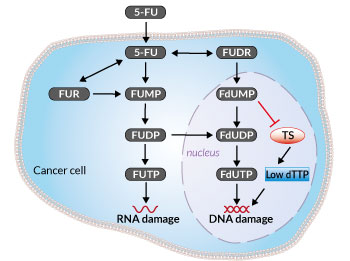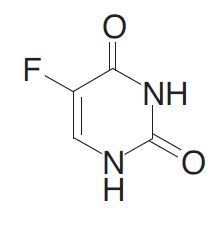DNA and RNA synthesis inhibitor
| Product | Unit size | Cat. code | Docs. | Qty. | Price | |
|---|---|---|---|---|---|---|
|
5-Fluorouracil Thymidylate synthase inhibitor |
Show product |
4 x 250 mg |
sud-5fu-4
|
|
Nucleobase analog for in vitro and in vivo cytotoxicity assays

Metabolism of 5-Fluorouracil (5-FU)
5-Fluorouracil (5-FU), a widely used chemotherapeutic agent, is an antimetabolic and antineoplastic agent [1-4]. This uracil analog, which mimics both uracil and thymine, interferes with nucleoside metabolism by incorporating into RNA and DNA triggering cytotoxicity and cell death. Of note, it irreversibly inhibits thymidylate synthase (TS) leading to a dNTP imbalance resulting in DNA damage and cell death [4].
Mode of action:
5-FU is a nucleobase analog of uracil in which the hydrogen at position 5 is replaced by fluorine [4]. It is a pyrimidine antagonist that functions by inhibiting DNA synthesis. As with all pyrimidine antagonists, 5-FU is a pro-drug and the intracellular conversion of 5-FU into 5-fluoro-uridine-monophosphate (FUMP) and 5-fluoro-deoxy-uridine-monophosphate (FdUMP) is essential for its action [4].
The active metabolite 5-FdUMP is an irreversible inhibitor of TS and hence of DNA synthesis through deoxythymidine triphosphate (dTTP) deprivation which in turn leads to apoptosis. As 5-FU is similar in shape but does not undergo the same chemistry as uracil, it inhibits RNA replication enzymes, thereby blocking RNA synthesis and stopping the growth of cancerous cells. Hence, the antitumor activity results from the inhibition of TS by FdUMP, as well as from the incorporation of 5-FU metabolites into RNA and DNA [1].
Cytotoxicity of 5-FU:
5-FU readily enters the cell using the same facilitated transport mechanism as uracil and is rapidly converted into cytotoxic nucleotides [2]. Therefore, to avoid systemic toxicity of 5-FU, doses must be minimized. For this reason, InvivoGen has created vectors carrying genes encoding uracil phosphoribosyltransferase (UPRT), an enzyme found in prokaryotes and lower eukaryotes but apparently absent from mammalian cells.
UPRT catalyzes the direct conversion of 5-FU to 5-FUMP, whereas in mammalian cells 5-FU is converted to 5-FUMP through the concerted action of two highly regulated enzymes. Consequently, the expression of UPRT substantially increases 5-FU cytotoxicity in transfected cells. UPRT encoding genes available from InvivoGen are E. coli upp and S. cerevisiae fur. Both genes were fused to cytosine deaminase genes to generate the following fusion genes: E. coli codA::upp and S. cerevisiae fcy::fur.
Key features of 5-FU:
- Antimetabolic and antineoplastic agent
- Inhibitor of thymidylate synthase
- Each lot is highly pure (≥97%)
InvivoGen products are for research purposes only; they are not for use in humans.
References:
1. Sethy C. & Kundu C.N., 2021. 5-Fluorouracil (5-FU) resistance and the new strategy to enhance the sensitivity against cancer: Implication of DNA repair inhibition. Biomed Pharmacother. 137:111285.
2. Entezar-Almahdi E. et al., 2020. Recent Advances in Designing 5-Fluorouracil Delivery Systems: A Stepping Stone in the Safe Treatment of Colorectal Cancer. Int J Nanomedicine . 15:5445-5458.
3. Tsukihara H. et al., 2016. Folic Acid-Metabolizing Enzymes Regulate the Antitumor Effect of 5-Fluoro-2'-Deoxyuridine in Colorectal Cancer Cell Lines. PLoS One. 11(9):e0163961.
4. Longley D.B. et al., 2003. 5-fluorouracil: mechanisms of action and clinical strategies. Nat Rev Cancer. 3(5):330-8.
Specifications
CAS number: 51-21-8
Working concentration: 1 - 300 µg/ml
Formula: C4H3FN2O2
Molecular weight: 130.1 g/mol
Quality control:
- Purity: ≥97% (UHPLC)
- The absence of bacterial contamination (e.g. lipoproteins and endotoxins) is confirmed using HEK-Blue™ TLR2 and HEK-Blue™ TLR4 cells.
Contents
- 4 x 250 mg at 10 mg/ml
![]() 5-FU is shipped at room temperature.
5-FU is shipped at room temperature.
![]() Upon receipt, store at room temperature in a cool and dark place.
Upon receipt, store at room temperature in a cool and dark place.
Details
Thymidylate synthase
Thymidylate synthase (TS) is a folate-dependent enzyme that catalyzes the conversion of deoxyuridine monophosphate (dUMP) to deoxythymidine monophosphate (dTMP). Thymidine is one of the nucleotides in DNA. With the inhibition of TS, an imbalance of deoxynucleotides and increased levels of dUMP arise leading to DNA damage.
In addition to its role in catalysis and cellular metabolism, studies have shown that TS functions as an RNA-binding protein.
Specifically, TS binds with high affinity to its own mRNA resulting in translational repression. Research has shown that TS interacts with the mRNAs of the c-Myc oncogene and the p53 tumor suppressor gene. These two genes have been shown to play critical roles in cell cycle control, DNA biosynthesis, and apoptosis.
In conclusion, TS appears to play a role as a mediator in the regulation of several critical aspects of cellular metabolism.
1.Chu E. & C J Allegra. C.J. 1996. The role of thymidylate synthase in cellular regulation. Adv Enzyme Regul. 36:143-63.
Chemical structure of 5-FU:





